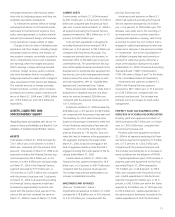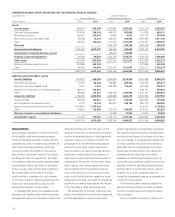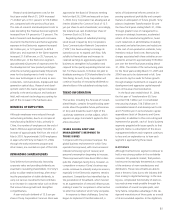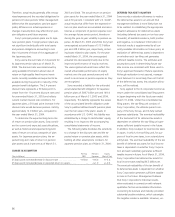Sony 2004 Annual Report Download - page 82
Download and view the complete annual report
Please find page 82 of the 2004 Sony annual report below. You can navigate through the pages in the report by either clicking on the pages listed below, or by using the keyword search tool below to find specific information within the annual report.
80
In addition, there are no financial covenants
that would cause an acceleration of the obliga-
tion in the event of a downgrade in Sony’s
credit ratings, in any of Sony’s material financ-
ing agreements.
RATINGS
In order to facilitate access to global capital
markets, Sony obtains credit ratings from two
rating agencies, Moody’s and S&P. In addition,
Sony maintains a rating from Rating and
Investment Information, Inc. (“R&I”), a rating
agency in Japan, for access to the Japanese
capital market.
Sony’s current debt ratings (long-term/
short-term) are: Moody’s: A1 (outlook: nega-
tive)/P-1; S&P: A+ (outlook: negative)/A-1; and
R&I: AA/a-1+.
On June 25, 2003, Moody’s downgraded
Sony’s long-term debt rating from Aa3 to A1
(outlook: negative). R&I downgraded Sony’s
long-term debt rating from AA+ to AA on
June 16, 2003. These actions reflected the
concerns of the two agencies that Sony may
take longer than initially expected to regain its
previous level of profit and cash flow under
the severe competition, particularly in the elec-
tronics business, and deflationary pressures.
Sony’s short-term debt rating from Moody’s
and R&I has been unaffected.
Despite the downgrading of Sony’s long-
term debt rating by Moody’s and R&I, Sony be-
lieves that its access to the global capital markets
will remain sufficient for its financing needs
going forward, and that it will retain its ability
to issue CP to meet its working capital needs.
Sony seeks to maintain a stable credit rating
in order to ensure financial flexibility for liquidity
and capital management, and to continue to
maintain adequate access to sufficient funding
resources in the financial and capital markets.
CASH MANAGEMENT
Sony is centralizing and working to make more
efficient its global cash management activities
through SGTS. The excess or shortage of cash
at most of its subsidiaries is invested or funded
by SGTS after having been netted out, although
Sony recognizes that fund transfer is limited in
certain countries or geographical areas due to
restrictions on capital transactions. In order to
pursue more efficient cash management, Sony
manages uneven cash distribution among its
subsidiaries directly or indirectly through SGTS
so that Sony can reduce unnecessary cash and
cash equivalents as well as borrowings as
much as possible.
The above description covers liquidity and
capital resources for consolidated Sony exclud-
ing Sony Life, Sony Assurance and Sony Bank,
each of which respectively secures liquidity on
its own.
FINANCIAL SERVICES SEGMENT
In the Financial Services segment, the manage-
ment of Sony Life, Sony Assurance and Sony
Bank recognize the importance of securing
sufficient liquidity to cover the payment obliga-
tions that they take on as a result of their
ordinary course of business. These companies
abide by the regulations imposed by regulatory
authorities and establish and operate under
company guidelines that comply with these
regulations. Their purpose in doing so is to main-
tain sufficient cash and cash equivalents and
secure sufficient means to pay their obligations.
Sony Life currently obtains ratings from four
rating agencies: A+ by S&P, A+ by AM Best
Corporation, and AA by R&I and the Japan
Credit Rating Agency Ltd. Sony Bank obtained
an A-/A-2 rating from S&P for its long-term/
short-term debt.
THE USE OF EVA® METHODOLOGY
Aiming to advance corporate value creation
management, Sony uses EVA®*, which reflects
cost of capital, as one of its internal evaluation
measures. The fiscal year ended March 31,
2004 marked the fourth year Sony has used
EVA®. EVA® is used in the Electronics, Game,
Music, and Pictures segments for various
internal evaluation measures such as setting,
monitoring and evaluating financial perfor-
mance targets. EVA® is also linked to compen-
sation. As a result, recognition of return on
invested capital and cost of capital has spread
further within each business unit and proactive
efforts have been made to improve EVA®.
These efforts include focusing on key busi-
nesses in order to concentrate management
resources in highly growing and profitable
areas and controlling investments and invento-
ries to improve capital efficiency.
*EVA® (Economic Value Added) is a trademark of Stern Stewart & Co.
RESEARCH AND DEVELOPMENT
Recognizing that research and development
are indispensable for business growth, Sony is
actively pursuing various technical themes,
including technologies that support current
services and those that will create new markets.
Sony has also done away with the organiza-
tional structure in which there was an Elec-
tronics Chief Technology Officer (“CTO ”), a
Co-CTO and several CTOs for each network
company, moving to a structure in which each
business domain has a CTO. In this way, a
single individual in each business domain over-
sees technological advances in that domain.
■ CTO of Home Electronics
■ CTO of Device Technology
■ CTO of Semiconductor Technology
■ CTO of Material Technology
■ CTO of Information Technology
Furthermore, in accordance with the
strengthening of research and development at
the network companies, the corporate labora-
tories were reorganized on April 1, 2004. In an
effort to reinforce basic research and develop-
ment activity in core science areas, two new
research laboratories were also established,
with the CTO of Material Technology and the
CTO of Information Technology each respon-
sible for one.
■ Materials Laboratories
■ Information Technologies Laboratories
In addition, two independent research labo-
ratories, Sony Computer Science Laboratories,
Inc. (fundamental research and user interface
research) and Sony-Kihara Research Center, Inc.
(three-dimensional computer graphics and
image processing technologies), are conducting
research and development in close collaboration
with each other.
























